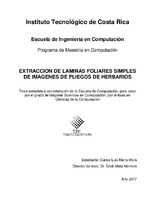Extracción de laminas foliares de imágenes de pliegos de herbarios
Resumen
This thesis describes an algorithmic approach for the automatic extraction of images of simple leaves of plants from digital images of herbal leaflets. We present a collection of tools that use computer vision algorithms and machine learning, supported by the OPENCV and Caffe development platforms. The research generated the following results: a convolutional neural network (CNN) with 5 layers of convolution and 3 layers of grouping and 3 fully connected layers, the network has the capacity to be re-trained to repeat the experiment. The network can identify sections of herbal sheets corresponding to leaves; an evaluation of system training using 25,000 images of segments of sheet, which includes leaves and non-leaves (3/4 for training, 1/4 for tests) takes an average of 6 minutes per 1,000 iterations, and stabilizes accuracy to 0.96 in less than 10,000 iterations. The validation process was carried out with 35,000 images of herbaria sheets taken from the herbariums of the University of Costa Rica, based in Golfito and the University of Arizona. The system presented a 0.75 accuracy when classifying an image as a leaf and a pressure greater than 0.99 when discarding an image as a leaf; this process extracted more than 300,000 segments and classified them into 6,000 leaves and 294,000 leaves on average. This database of 300,000 images automatically extracted by the convolutional network is available on the Internet for testing systems based on plant leaves to make species identifications.
Descripción
Proyecto de Graduación (Maestría en Computación) Instituto Tecnológico de Costa Rica, Escuela de Ingeniería en Computación, 2018.
Compartir
Métricas
Colecciones
- Maestría en Computación [119]


